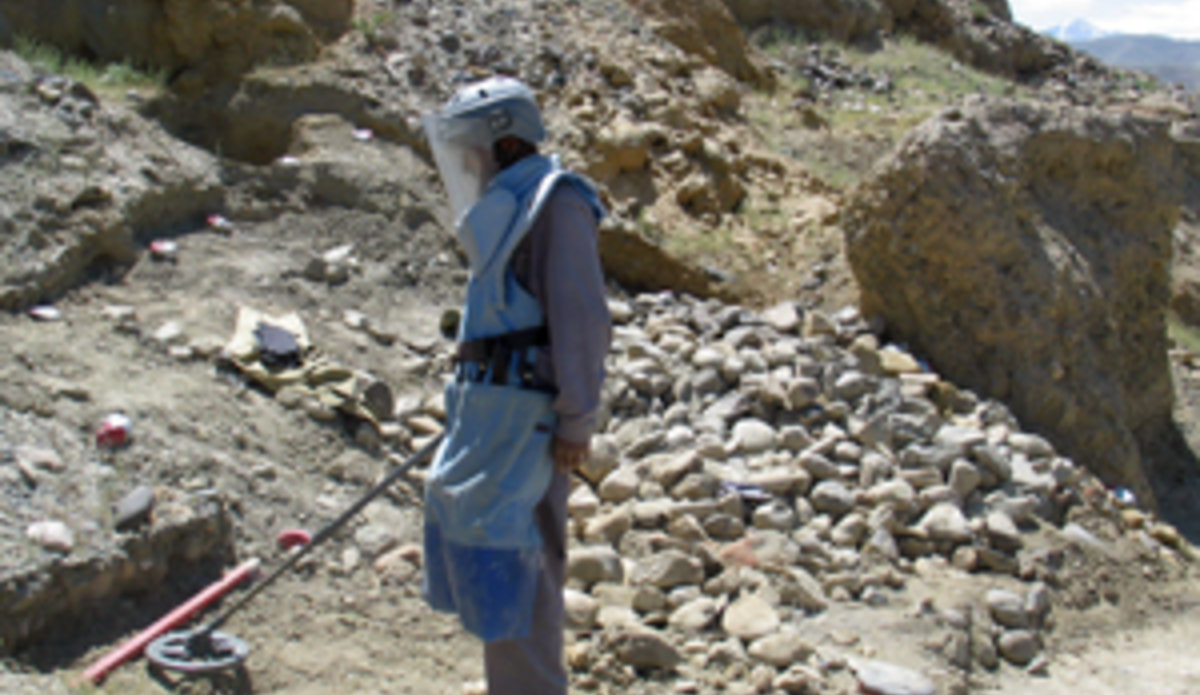Deminers in the firing line
KABUL - Taliban insurgents and other armed groups as well as criminal gangs in Afghanistan have been deliberately targeting demining NGOs, particularly in the volatile southern provinces, says the Afghanistan NGO Safety Office (ANSO).
At least 10 deminers were killed, 23 injured and 12 abducted in 2010, said ANSO.
ANSO’s figures differed from those supplied to IRIN by the UN-affiliated Mine Action Coordination Center for Afghanistan (MACCA), which said 17 deminers were killed, 35 injured and 73 abducted in 2010.
“Most commonly it [insurgent opposition to demining activities] is simply to do with them clearing areas that the IEA [Islamic Emirate of Afghanistan] wants to leave untouched perhaps because they laid the field, or benefit from it not being usable by other forces,” ANSO director Nic Lee told IRIN.
In some instances, attacks on deminers were preceded by warnings, and sometimes “high-profile demining support vehicles” were mistaken for security targets and attacked, he said.
ANSO advises NGOs to seek security through transparent dialogue with all combatants and avoid involvement in counterinsurgency activities.
“We have not made any additional recommendations to them [deminers] specifically, other than to highlight that attacks against them account for a high percentage of NGO events,” said Lee, adding that demining organizations were professional and understood the risks they were taking.
Targeted
Attacks on NGOs in 2010 were down by 27 percent on 2009 but fatalities rose by 42 percent, and a high percentage of deaths were among deminers. Of the 28 NGO members killed, eight were foreigners and half of the remainder were Afghan deminers, according to ANSO.
"Without doubt the purpose of some attacks is precisely what it seems to be, to kill or injure NGO staff. Of the 51 cases under review here, we assess that eight (14 percent) fall into this worst of categories, but more alarmingly seven of these [attacks] targeted demining organizations. This reflects a clear and direct opposition to the work of deminers," said an ANSO report covering the fourth quarter of 2010 seen by IRIN and due to be published on the ANSO website soon.
ANSO’s third quarter report spelt out the risks facing deminers: “The data suggests that the highest risk of kinetic attack remains towards demining NGOs who can be attacked for their perceived role in battlefield clearance as well as the superficial similarity of their vehicle convoys to those of security forces, while others are at risk of
1) accidental targeting especially with an IED [improvised explosive device]
2) circumstantial encounter with AOG [armed opposition group] at a check-post and
3) murder by AOG in a lawless area….
The data shows that the only NGO staff deliberately targeted [ANSO italics] by the IEA this year have been deminers.”
Armed violence hit unprecedented levels across the country in 2010, with an average of 800 security incidents per month, and there are no signs of it abating in 2011, ANSO said.
Demining agencies have detected and destroyed millions of landmines and other explosive remnants of war (ERWs) in Afghanistan over the past three decades but in some parts of the country landmines and ERWs still kill and maim dozens of people every month.
Over 14,000 people are working for demining organizations in Afghanistan, MACCA’s director Haider Reza told IRIN, adding that the general environment of insecurity and criminality was largely to blame for casualties among deminers.
“Respected… as neutral”
“Deminers are widely respected in Afghanistan as neutral humanitarian workers,” said Reza, adding that Taliban “supreme leader” Mullah Omar issued a decree in support of demining activities in 1996.
Farid Homayoun, director of the demining NGO Halo Trust International, told IRIN his organization was sensitive to local demands and focused on pre-2001 mines: “We closely work with local communities and only clear the areas which the local people want us to clear… We are only clearing landmines left from the Russians [1979-1989] and the internal [1992-2001] wars.”
“We don’t believe we are deliberately attacked… We’re not a target,” said Homayoun, adding that one Halo Trust deminer was killed last year and several others kidnapped but later released.
No Taliban spokesman was immediately available to comment about the group’s position on demining organizations, though demining activities were allowed under the Taliban in 1995-2001.
The insurgents are known to have used IEDs and landmines in their fight against pro-government forces, disproportionately harming civilians, according to the UN and other human rights groups.
Afghanistan is a signatory to the Ottawa Convention on Landmines and the government says it has already destroyed all its landmine stockpiles and has stopped importing and using them.
Demining agencies have set 2013 as a deadline to rid Afghanistan of all landmines. However, given the growing violence, it remains to be seen whether this target is achievable, say experts.
By IRIN
 UN
UN






